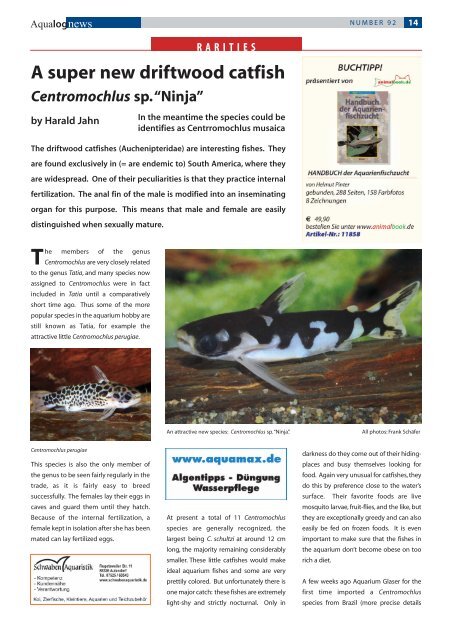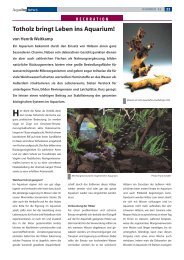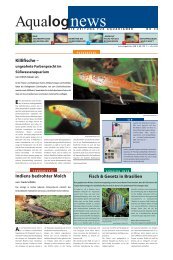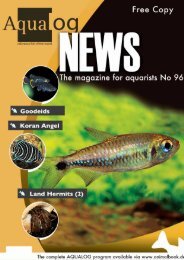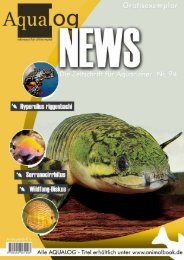A super new driftwood catfish - Aqualog
A super new driftwood catfish - Aqualog
A super new driftwood catfish - Aqualog
Create successful ePaper yourself
Turn your PDF publications into a flip-book with our unique Google optimized e-Paper software.
<strong>Aqualog</strong><strong>new</strong>s NUMBER 92 14<br />
T<br />
he members of the genus<br />
Centromochlus are very closely related<br />
to the genus Tatia,and many species now<br />
assigned to Centromochlus were in fact<br />
included in Tatia until a comparatively<br />
short time ago. Thus some of the more<br />
popular species in the aquarium hobby are<br />
still known as Tatia, for example the<br />
attractive little Centromochlus perugiae.<br />
RARITIES<br />
A <strong>super</strong> <strong>new</strong> <strong>driftwood</strong> <strong>catfish</strong><br />
Centromochlus sp.“Ninja”<br />
by Harald Jahn<br />
The <strong>driftwood</strong> <strong>catfish</strong>es (Auchenipteridae) are interesting fishes. They<br />
are found exclusively in (= are endemic to) South America, where they<br />
are widespread. One of their peculiarities is that they practice internal<br />
fertilization. The anal fin of the male is modified into an inseminating<br />
organ for this purpose. This means that male and female are easily<br />
distinguished when sexually mature.<br />
Centromochlus perugiae<br />
This species is also the only member of<br />
the genus to be seen fairly regularly in the<br />
trade, as it is fairly easy to breed<br />
successfully. The females lay their eggs in<br />
caves and guard them until they hatch.<br />
Because of the internal fertilization, a<br />
female kept in isolation after she has been<br />
mated can lay fertilized eggs.<br />
In the meantime the species could be<br />
identifies as Centrromochlus musaica<br />
An attractive <strong>new</strong> species: Centromochlus sp.“Ninja”. All photos: Frank Schäfer<br />
At present a total of 11 Centromochlus<br />
species are generally recognized, the<br />
largest being C. schultzi at around 12 cm<br />
long, the majority remaining considerably<br />
smaller. These little <strong>catfish</strong>es would make<br />
ideal aquarium fishes and some are very<br />
prettily colored. But unfortunately there is<br />
one major catch: these fishes are extremely<br />
light-shy and strictly nocturnal. Only in<br />
darkness do they come out of their hidingplaces<br />
and busy themselves looking for<br />
food. Again very unusual for <strong>catfish</strong>es, they<br />
do this by preference close to the water’s<br />
surface. Their favorite foods are live<br />
mosquito larvae, fruit-flies, and the like, but<br />
they are exceptionally greedy and can also<br />
easily be fed on frozen foods. It is even<br />
important to make sure that the fishes in<br />
the aquarium don’t become obese on too<br />
rich a diet.<br />
A few weeks ago Aquarium Glaser for the<br />
first time imported a Centromochlus<br />
species from Brazil (more precise details
<strong>Aqualog</strong><strong>new</strong>s NUMBER 92 15<br />
Note the interesting structure of the upper-jaw barbels.<br />
are so far not available) whose spectacular coloration makes it<br />
seemed destined to become a much-prized aquarium fish. The<br />
species exhibits certain similarities to Centromochlus concolor from<br />
Guyana, but has a quite distinct coloration. On the basis of<br />
information currently available the species is probably as yet<br />
undescribed scientifically. The specimens imported measure 4-6<br />
cm in length.<br />
Obviously there isn’t too much that can be said about the<br />
maintenance, let alone the breeding, of such <strong>new</strong> imports.<br />
However, so far these fishes have proved comparable to<br />
Centromochlus perugiae, which is also why this species has been<br />
discussed in some detail above.<br />
The structure of the upper-jaw barbels in these <strong>catfish</strong>es is very<br />
interesting. While the lower-jaw barbels extend more or less rigidly<br />
downwards, the upper-jaw barbels can be folded backwards, and<br />
this is essentially what the <strong>catfish</strong>es do when at rest. So that the<br />
barbels won’t lie across the large eye - a typical character of<br />
nocturnal and crepuscular fishes – in the resting position, they have<br />
a downward-pointing concavity. When the fishes swim around in<br />
search of food or to orient themselves, the upper-jaw barbels are<br />
unfolded and their special structure becomes apparent.<br />
Lexicon:<br />
Centromochlus:from the ancient Greek "with a Hebelstab", referring to the<br />
pectoral-fin spines, which can be fixed in place with a locking mechanism.<br />
perugiae:<br />
dedication name<br />
in honor of A.<br />
Perugia, who was<br />
an ichthyologist at<br />
the museum in<br />
Triest.<br />
Tatia:in honor of<br />
Charles Tate<br />
Regan, who was<br />
an ichthyologist at<br />
the British<br />
Museum.<br />
concolor: Latin,<br />
meaning “all the<br />
same color”.<br />
Discus Royal Blue Nhamunda<br />
Barbus fasciatus wild<br />
A c t u a l<br />
i m p o r t s f r o m<br />
a l l o v e r t h e<br />
w o r l d<br />
Nannacara adoketa Pseudacanthicus leopardus<br />
Corydoras sp.“New Panda” CW 49<br />
Discus Heckel Jatapu<br />
Channa sp.“Dwarf Redfin”<br />
w w w . a q u a r i u m g l a s e r . d e


